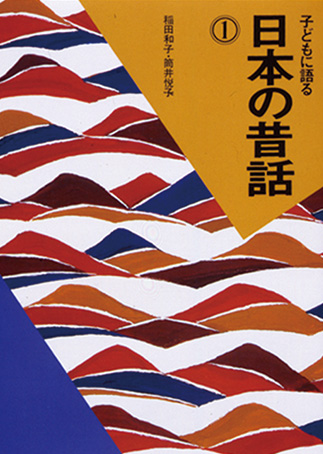
Kodomo ni kataru Nihon no mukashi-banashi 1–3
[Japanese Folktales to Tell to Children, Vols. I–III]
Kogumasha, 1995–1996. ISBN 978-4-7721-8029-0.
Also published in: n/a
Every Japanese person knows “Momotarō” [trans. Peach Boy], the story of a boy born from a peach who sets off to fight ogres. It is considered one of the “five great Japanese folktales,” alongside “Kachikachi-yama” [trans. Click-Clack Mountain], “Saru to kani” [trans. The Monkey and the Crab], “Shitakiri suzume” [trans. The Tongue-cut Sparrow], and “Hanasaka-jii” [trans. The Old Man Who Made Flowers Bloom]. This three-volume collection contains these famous stories and more, offering a huge range of traditional tales, humorous tales, tales with no end, and rare tales unique to specific regions. (There are 25 tales each in Vol. I and III, and 23 tales in Vol. II.)
Folktales began as oral literature, and are best enjoyed aloud. Japanese folktales are filled with variety due to the unique sounds and rhythms of each region’s dialect. Tsutsui Etsuko has a wealth of experience from years of telling stories to children, and here she takes stories collected by folktale researcher Inada Kazuko and retells them to make them easier to read aloud and more enjoyable for children.
Although ease of understanding for today’s children reading the stories—or hearing them read—is prioritized, the essence of each tale is faithfully preserved. Formulas to start and end stories, “magic words,” and conversations are left in their dialect forms to convey the atmosphere of each region and the charm of the language. This lets readers enjoy the linguistic atmosphere and rhythms of each tale’s home region. At the end of each volume is a brief explanation of the prefecture or region where the tales contained were collected, and how the children there respond to them. An ideal set for learning more about the origins of various folktales and the value of telling them to children. (SJ)
Folktales began as oral literature, and are best enjoyed aloud. Japanese folktales are filled with variety due to the unique sounds and rhythms of each region’s dialect. Tsutsui Etsuko has a wealth of experience from years of telling stories to children, and here she takes stories collected by folktale researcher Inada Kazuko and retells them to make them easier to read aloud and more enjoyable for children.
Although ease of understanding for today’s children reading the stories—or hearing them read—is prioritized, the essence of each tale is faithfully preserved. Formulas to start and end stories, “magic words,” and conversations are left in their dialect forms to convey the atmosphere of each region and the charm of the language. This lets readers enjoy the linguistic atmosphere and rhythms of each tale’s home region. At the end of each volume is a brief explanation of the prefecture or region where the tales contained were collected, and how the children there respond to them. An ideal set for learning more about the origins of various folktales and the value of telling them to children. (SJ)

Translation rights inquiries
KOGUMA Publishing Co., Ltd.
(attn. Onishi Maiko, Editorial Dept.)
Email: onishi@kogumasha.co.jp
(When sending an e-mail, please enter a half-width character "@" instead of a full-width character "@.")



